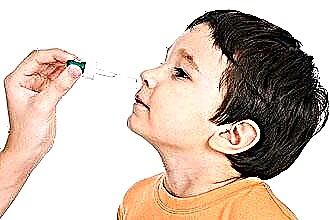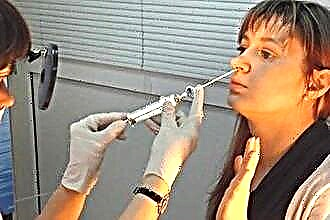Epistaxis or epistaxis is a fairly common problem. Children most often encounter it, since their mucous membrane is quite thin, and the vessels are fragile and located very close to the surface. However, trouble can happen with mature people. To help a person, you need to know how to stop nosebleeds at home.
Why does epistaxis appear
 Nosebleeds occur for various reasons, most often it is associated with injury to the soft and bone tissues of the organ. However, there are diseases that cause frequent hemorrhages, in which case we are talking about systemic epistaxis.
Nosebleeds occur for various reasons, most often it is associated with injury to the soft and bone tissues of the organ. However, there are diseases that cause frequent hemorrhages, in which case we are talking about systemic epistaxis.
Let us consider in more detail the reasons leading to the occurrence of the violation. Local factors include:
- receiving injuries leading to a violation of the integrity of the mucous membrane, bone tissue and skin, blood vessels and capillaries;
- medical manipulations (operations, examinations using instruments inserted into the nostrils, etc.);
- the presence of foreign bodies in the nasal passages;
- an acute inflammatory process in the upper respiratory tract, causing swelling of the mucous membrane, its irritation and exhaustion;
- overdose with vasoconstrictor drops and sprays;
- strong blowing of your nose;
- negative impact of critical temperatures on the nasal cavity (inhalation of too hot or overcooled air);
- the presence of neoplasms in the nasal cavity;
- violations of the structure of the nose;
- taking narcotic substances by inhalation through the nose.
Systemic causes are directly related to chronic bleeding disorders.
It can be an imbalance of hormones in the body, high blood pressure, high fragility of blood vessels and capillaries, vitamin deficiency, blood clotting disorders, sudden changes in atmospheric pressure. A sharp rise in body temperature can also lead to sudden epistaxis.
Classification of violation
According to the amount of blood lost during epistaxis and its localization, several types are distinguished. By location, bleeding is classified as follows:
- Front. The source of bleeding is the Kisselbach plexus - a dense mesh of arterioles and capillaries that supplies blood to the nasal cartilage and the anterior parts of the organ. Such epistaxis happens in more than 90% of cases, its stopping at home is successful, blood loss is small.

- Rear. This type of bleeding is caused by damage to one of the large capillaries or its branches located in the posterior or middle part of the nasal cavity. It is quite rare, but is characterized by severe blood loss and the impossibility of stopping it without medical help.
According to the amount of blood loss, epistaxis is divided into 4 groups:
- lung (the patient loses up to 100 ml of blood and at the same time his condition does not worsen);
- massive (blood loss is 100-500 ml, does not pose a threat to life, but negatively affects health);
- severe (the patient can lose 500-1100 ml of blood, while his condition deteriorates markedly and a serious threat to life appears);
- especially severe (more than 1100 ml of blood flows out, even the help of doctors is not always effective, a lethal outcome is possible).
First aid to the patient
It is possible to prevent the development of complications in a person with epistaxis if you know how to stop a nosebleed in an adult at home. There are several methods for eliminating the violation, which must be used in turn, strictly following the instructions.
Let's consider in more detail how to behave when providing first aid.
- We fix the patient's head in a comfortable position. To do this, do not throw it back, as most people do. Pulling the head back can only aggravate the situation, since there will only be a false appearance of stopping the blood. In fact, it will continue to flow, but not from the nostrils, but along the back wall of the nasopharynx. This can cause bloody vomiting. A high risk is the flow of blood into the respiratory tract. To protect the patient as much as possible from unpleasant complications, he must be seated flat on a chair or laid on a high pillow and his head resting on his side, this minimizes the possibility of choking on his own blood.
 We press the nostrils. Before stopping nosebleeds at home, you need to find out from which nostril the discharge is more abundant. It is this part of the nose that must be gently pressed against the bridge of the nose; you cannot press hard, so as not to damage the capillaries.
We press the nostrils. Before stopping nosebleeds at home, you need to find out from which nostril the discharge is more abundant. It is this part of the nose that must be gently pressed against the bridge of the nose; you cannot press hard, so as not to damage the capillaries.- We put on a cold compress. Cold acts as a vasoconstrictor, so it can be used to eliminate epistaxis. Take a bag filled with ice or a textile handkerchief soaked in cold water and place it on the bridge of your nose. Next, apply a compress to the neck to help relieve the pressure. A towel soaked in cold water should be wrapped around your neck. The patient should sit with a cold compress for no more than 10 minutes, if there are no changes for the better, an ambulance should be called.
- Contrast baths. This technique can be used to relieve pressure in the upper torso. The patient's arms are lowered to the elbows in the coldest water, you can even add ice to it. But the legs are placed in a bowl of hot water. This temperature contrast will ensure the outflow of blood from the head and help stop epistaxis.
- Compresses with vasoconstrictor drops. This rule can only be used if the bleeding is not too severe. To eliminate the problem, we will need any vasoconstrictor drops that are in the home first-aid kit ("Naphtizin", "Tizin", "Nazivin", etc.). We will make a compress from them. To do this, we take a cotton turunda and moisten it in the preparation, insert it into the nostrils and leave it for 30 minutes. After that, very carefully, so as not to cause a relapse of epistaxis, we remove the tampons.
- Peroxide compress. Hydrogen peroxide (3% solution) can also be used to stop the blood. In the same way as in the case with the previous compresses, we dip the cotton wool in the liquid and inject it into the nasal passages. We hold the turunda in the nose for 15 minutes, after which we very carefully remove and drip 1 drop of vasoconstrictor drugs to prevent re-bleeding.
- Hemostatic sponge. This remedy is sold in pharmacies and should be in every person who suffers from frequent epistaxis. For first aid, you need to tear off a piece of a sterile sponge, put it in the nostril and gently press it with your finger. The condition will return to normal within a couple of minutes. It is not necessary to remove the sponge from the passages, it is self-absorbing. Active ingredients promote rapid healing.
Precautionary measures
 Most often, epistaxis is easily eliminated with the help of first aid at home, but sometimes all methods are powerless. If there is no improvement within half an hour, you cannot do without medical help. It is also worth understanding that with profuse blood loss, it is better to immediately call an ambulance, and then begin to provide first aid.
Most often, epistaxis is easily eliminated with the help of first aid at home, but sometimes all methods are powerless. If there is no improvement within half an hour, you cannot do without medical help. It is also worth understanding that with profuse blood loss, it is better to immediately call an ambulance, and then begin to provide first aid.
With severe bruises and injuries, the patient can literally bleed out in just a few minutes, therefore it is important to react to the situation in time and do everything possible so that the doctors arrive on time.
It is also worth remembering that with systemic diseases, bleeding can be repeated very often, they can be completely eliminated only if you get rid of the cause of epistaxis.Acute and chronic inflammation of the mucous membrane requires systemic drug treatment, it is also prescribed for bleeding disorders or other serious ailments.
Elimination of neoplasms in the nasal passages almost always requires surgical intervention, this is the only way to get rid of the tumors themselves and the symptoms they cause 100%.
Let's sum up
When the nose bleeds, a person needs to be helped to stop it from the first seconds of the onset of the disorder. Providing assistance before the arrival of doctors is an important step in helping to prevent serious consequences. However, even if it was possible to stop the blood at home, you still need to be examined by an ENT specialist and identify the cause that provoked the violation.
Monitor your health and seek professional help in time.

 We press the nostrils. Before stopping nosebleeds at home, you need to find out from which nostril the discharge is more abundant. It is this part of the nose that must be gently pressed against the bridge of the nose; you cannot press hard, so as not to damage the capillaries.
We press the nostrils. Before stopping nosebleeds at home, you need to find out from which nostril the discharge is more abundant. It is this part of the nose that must be gently pressed against the bridge of the nose; you cannot press hard, so as not to damage the capillaries.

